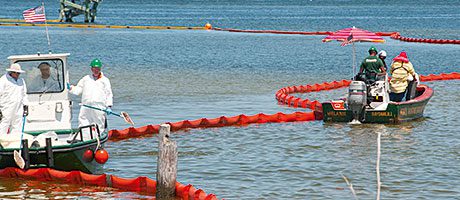RESEARCHERS at an American institute have developed a new technique for magnetically separating oil and water that could be used to clean up oil spills.
They believe the technique could recover the oil for use and offset much of the cost of clean-up operations.
The team will present its work at January’s International Conference on Magnetic Fluids, to be held in India.
Shahriar Khushrushahi of the department of electrical engineering and computer science at Massachusetts Institute of Technology, is lead author on the paper, joined by electrical engineering professor Markus Zahn and chemical engineering professor Alan Hatton. They have also filed two patents on their work.
In the MIT researchers’ scheme, water-repellent ferrous nanoparticles would be mixed with the oil, which could then be separated from the water using magnets. The researchers envisage that the process would take place aboard an oil-recovery vessel to prevent the nanoparticles contaminating the environment. Afterward, the nanoparticles could be magnetically removed from the oil and reused.

According to Zahn, there’s a good deal of previous research on separating water and so-called ferrofluids — fluids with magnetic nanoparticles suspended in them. Typically, these involve pumping a water-and-ferrofluid mixture through a channel, while magnets outside the channel direct the flow of the ferrofluid, perhaps diverting it down a side channel or pulling it through a perforated wall.
This approach can work if the concentration of the ferrofluid is known in advance and remains constant. But in water contaminated by an oil spill, the concentration can vary widely. “Suppose that the separation system consists of a branching channel with magnets along one side. If the oil concentration were zero, the water would naturally flow down both branches. By the same token, if the oil concentration is low, a lot of the water will end up flowing down the branch intended for the oil; if the oil concentration is high, a lot of the oil will end up flowing down the branch intended for the water.”
The researchers vary the conventional approach in two major ways: They orient their magnets perpendicularly to the flow of the stream, not parallel to it, and they immerse the magnets in the stream, rather than positioning them outside of it.
The magnets are permanent magnets, and they’re cylindrical. Because a magnet’s magnetic field is strongest at its edges, the tips of each cylinder attract the oil much more powerfully than its sides do.
In experiments the MIT researchers conducted in the lab, the bottoms of the magnets were embedded in the base of a reservoir that contained a mixture of water and magnetic oil; consequently, oil couldn’t collect around them. The tops of the magnets were above water level, and the oil shot up the sides of the magnets, forming beaded spheres around the magnets’ ends.
“The design is simple but it provides excellent separation between oil and water,” said the authors.







